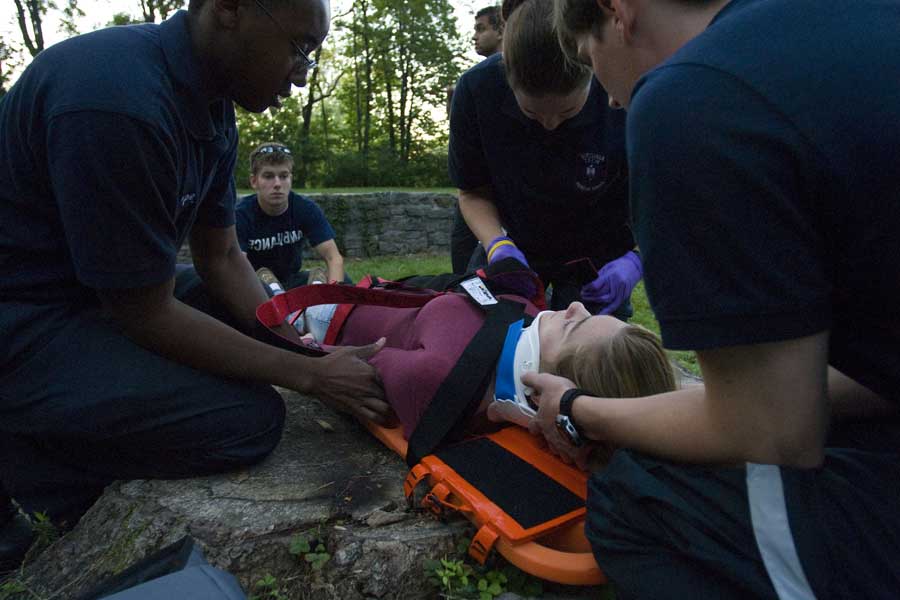Virginia Tech Rescue Squad volunteer students form bonds, provide service

In the Virginia Tech Rescue Squad, committed student volunteers take sole responsibility for operating and staffing, making it unique throughout its almost 40-year history. The group has achieved a highly respected position on the Virginia Tech campus and within the surrounding community, responding to over 900 calls each year.
As today’s members will tell you, it is not an easy job and can be time-consuming, but there is a very special feeling of accomplishment and reward that fuels the squad family’s continuing push for excellence.
Joanna Romanyshyn of Fairfax, Va., a senior majoring in biological sciences in the College of Science, made her initial commitment to the Virginia Tech Rescue Squad during a Drillfield recruitment drive on Virginia Tech’s campus.
“Why not?” she says she recalls thinking. Seven semesters later, she continues her Virginia Tech Rescue Squad service as vice president, public information officer, and attendant.
James Downing of Roanoke, Va., a senior majoring in mechanical engineering in the College of Engineering is also the current squad president and driver. Downing was also a newcomer when Joanna joined, and both became part of the spring 2005 probationary class. Along with increasing their skills, they say they found themselves fast becoming essential components of not just an organization, but also a very connected alternative family. The squad has a life of its own, it seems, and its members are what give it breath.
Excellence is what the Virginia Tech Rescue Squad consistently produces, most notably receiving the Governor’s Award for Outstanding Emergency Medical Services Agency in 2000 and the American Ambulance Association’s Stars of Life Award in May 2007. Both awards represent pinnacles of achievement in rescue care and training, and the fact that they were given to honor a volunteer student organization speaks to the high levels of contributor effort that is key to such success.
The squad also received a citation from the U.S. Department of Homeland Security (PDF) commending the Virginia Tech Rescue Squad for its work on April 16, 2007. The citation was written by Federal Emergency Management Agency Administrator R. David Paulison.
Students offer their time, energy, and brainpower. Sometimes joined by squad alumni, elder members educate novices. Trainees begin traveling with an active crew once they have mastered the basics. All volunteers are required to achieve emergency medical technician certification during their first year with the squad, and put in 20 to 30 hours of shift duty per week as they respond collectively to over 900 calls yearly.
On-duty crews await calls at the current squad facility, an old mailroom on Barger Street, though planning for new accommodations has begun. Along with continuing education and review, this is time generally spent eating, watching movies, playing video games, and simply getting to know fellow squad members. Some of the longer nighttime hours on call are spent napping in the back bunkroom.
One result of this enforced close companionship is the blossoming and growth of relationships that, according Romanyshyn, are a motivating factor in her long-term service to the squad. “I continue because the squad contains some of my best friends at Virginia Tech. It’s impossible to spend so much time together and not get along. We enjoy being together on and off duty,” she says.
Alisa Nussman of Chesterfield, Va., a junior majoring in human nutrition, foods, and exercise in the College of Agriculture and Life Sciences, is currently the squad’s director of special projects. Nussman said: “I feel like this rescue squad gives me a purpose on campus — that I can truly help and give back to this community which has given me so much. The squad is my second family – my closest friends are here.”
They’re not all alike, these student volunteers. They come from a wide variety of backgrounds and disciplines, and their motives for doing this work differ as well; still, the 28 active members of today’s Virginia Tech Rescue Squad join together to do their part. While speaking about the VT-ENGAGE volunteer initiative, James Downing calculates the squad’s part in the university’s 300,000 hour goal in this way. “We have four members on duty seven days a week, 24 hours a day. We’re roughly one-tenth of one percent of the entire university, yet we put in about 10 percent of the total (goal) volunteer hours.” Any way you figure it, that’s a pretty impressive contribution.
Romanyshyn admits: “Sometimes it’s difficult to put emotions aside, because some things you see are really sad.” She also recalls how rewarding it is – how good it can feel – when someone they have helped says thank you. “It really lets you know that people appreciate the hard work and dedication that go into this job.”
Although membership classes begin anew at the beginning of each semester, applications are accepted at any time throughout the year.
Written by Sharon Crane.




